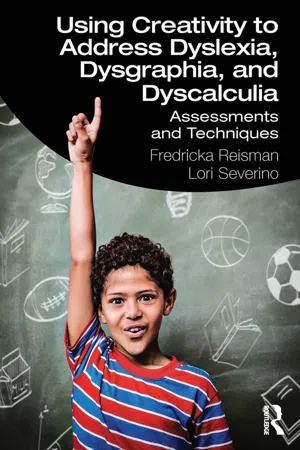
Using Creativity to Address Dyslexia, Dysgraphia, and Dyscalculia
Assessments and Techniques
- 290 pages
- English
- ePUB (mobile friendly)
- Available on iOS & Android
Using Creativity to Address Dyslexia, Dysgraphia, and Dyscalculia
Assessments and Techniques
About this book
Designed to help educators recognize and nurture students with dyslexia, dysgraphia, and dyscalculia, this book guides readers through best practices for using creativity theory and strategies to address the learning challenges for students who have difficulty in acquiring literacy and mathematics content.
Offering concrete examples of creativity assessment and pedagogical techniques, chapters are supported by rich appendices providing assessment and screening checklists, time telling objectives, learning trouble spots, a creative approach to teaching place value, and a handy cross-referencing table.
Accessible and thorough, this up-to-date guide will help educators develop strategies that acknowledge students' creative strengths to address learning challenges across the literacy and mathematics curricula.
Frequently asked questions
- Essential is ideal for learners and professionals who enjoy exploring a wide range of subjects. Access the Essential Library with 800,000+ trusted titles and best-sellers across business, personal growth, and the humanities. Includes unlimited reading time and Standard Read Aloud voice.
- Complete: Perfect for advanced learners and researchers needing full, unrestricted access. Unlock 1.4M+ books across hundreds of subjects, including academic and specialized titles. The Complete Plan also includes advanced features like Premium Read Aloud and Research Assistant.
Please note we cannot support devices running on iOS 13 and Android 7 or earlier. Learn more about using the app.
Information
SECTION 1
Background Information
1
DEFINING CREATIVITY, DYSLEXIA, DYSGRAPHIA AND DYSCALCULIA
- What does a creative nurturing classroom look like?
- Teachers foster a climate in which creative thinkers are respected, students and teachers tolerate new ideas, conformity is not imposed, and diversity in ideas is encouraged and appreciated (Cropley, 2006).
- How can teachers improve creative thinking in students?
- By providing choices, rewarding different ideas and products, encouraging sensible risks, and emphasizing students’ strengths and interests (de Souza Fleith, 2000; Kaufman & Sternberg, 2007).
- What happens when teachers are aware of and model their own creativity?
- Creative learning is likely to occur (Jeffery, 2006; Rejskind, 2000). Teachers can self-assess their own creativity using the Reisman Diagnostic Creativity Assessment (RDCA) presented in Chapter 5. Knowing your own creative strengths can increase the likelihood that you will model creative strategies in your own classroom.
Defining Creative Thinking

| Expert | Creativity Definition |
|---|---|
| | |
| Carl Rodgers (psychologist) | the essence of creativity is novelty, and hence we have no standard by which to judge it (Rogers, 1961) |
| John Haefele (CEO and entrepreneur) | the ability to make new combinations of social worth (Haefele, 1962) |
| Mihaly Csikszentmihalyi (psychologist, academic, writer) | any act, idea, or product that changes or transforms an existing domain into a new one (Csikszentmihalyi, 2013) |
| Robert Sternberg (psychologist) | The ability to produce work that is novel (original) and adaptive with respect to task or situational constraints (Sternberg & Lubart, 1995) |
| Ellis Paul Torrance (psychologist) | a process of becoming sensitive to problems, deficiencies, gaps in knowledge, missing elements, disharmonies, and so on; identifying the difficult, searching for solutions, making guesses, or formulating hypotheses and possibly modifying and retesting them; and finally communicating the results (Torrance, 1966) |
Table of contents
- Cover
- Half Title
- Title Page
- Copyright Page
- Dedication Page
- Contents
- Author Biographies
- Acknowledgments
- Introduction
- Section 1 Background Information
- Section 2 Assessment Activities
- Section 3 Teaching Activities
- Appendix A: Some Trouble Spots in the Primary Grades Mathematics Curriculum
- Appendix B: Teachers’ Review of Selected Mathematics Content
- Appendix C: Squelchers
- Appendix D: Cross-Reference Chart: Lesson X Developmental Curriculum X Generic Influence X RDCA Factor
- Appendix E: Developmental Mathematics Curriculum Screening Checklist K–12
- Appendix F: Developmental Literacy Curriculum Screening Checklist
- Appendix G: Observation of Generic Influences on Learning: Tips for Teachers
- Appendix H: Time Telling Objectives
- Index